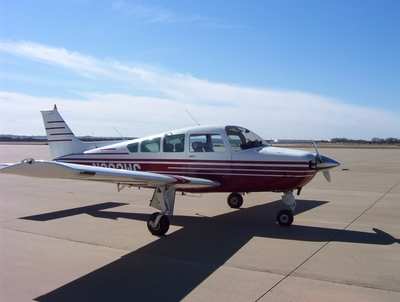Had Been Purchased At An Estate Sale, Went Down On Check-Out Flight
This is a cautionary tale with the message that, in the case of an airplane that has been sitting for a long, and indefinite amount of time, you can't just gas it up and go. Fortunately both people on board the Beech Sierra survived the accident with minor injuries.

The new owner of the Sierra was not quite that uncautious, but it may be a long time before his newly-acquired airplane flies again.
According to the NTSB's preliminary report, On May 10, 2016, about 1215 Pacific daylight time, a Beech B24R Sierra, N2052L, was substantially damaged when it impacted terrain during an attempted departure from Pine Mountain Lake airport (E45) in Groveland, CA. The pilot and the passenger/owner received minor injuries. The personal flight was conducted under the provisions of Title 14 Code of Federal Regulations Part 91. Visual meteorological conditions prevailed.
The passenger, who was a student pilot, recently purchased the airplane in an estate sale. Both the pilot and owner lived in Mississippi, and had traveled to E45 to retrieve the airplane, and fly it back to Mississippi. The airplane had been kept at E45, and reportedly had not been maintained, operated, or flown in at least 5 years, and possibly 10 or more. The airplane's most recent FAA registration expired in 2011. Subsequent to the purchase, the owner contracted with a mechanic at E45 to conduct maintenance on it, in preparation for the flight to Mississippi.
The day prior to the accident, both fuel tanks were filled, and the pilot and owner took the airplane for its first flight after its dormancy. The airplane departed on runway 27, and flew one circuit in the pattern, as planned. That flight was uneventful. The next day, they planned to again fly the airplane, this time departing the area for some systems evaluations before returning to E45. This takeoff attempt, which terminated in the accident, was conducted on runway 9. The pilot reported that the first part of the takeoff roll and liftoff "appeared normal but during or at gear retraction the aircraft started losing power." He stated with about 1,000 feet of runway remaining, the engine "was not producing enough power to climb or accelerate," and that it was apparent the airplane not going to clear the trees beyond the runway end. The pilot focused on attempting to climb, while simultaneously avoiding a stall.
The airplane struck trees and a utility pole, and then thick underbrush and the ground. The airplane came to rest about 1,800 feet beyond the end of the runway, at a point slightly north of the extended runway centerline. The fracture-separated outboard right wing was located adjacent to the utility pole, and the engine had separated from the fuselage. The fuselage was slightly crumpled and otherwise deformed, but the cabin retained its normal occupiable volume. There was no fire.
The pilot reported that for both flights, he was seated in the left seat, and was the sole manipulator of the controls. He held an airline transport pilot certificate, and reported about 22,800 total hours of flight experience, including about 4,310 hours in single engine airplanes. Prior to his flight in the airplane the day before the accident, the pilot had no experience in the accident airplane make and model. His most recent flight review was completed in May 2015, and his most recent FAA third-class medical certificate was issued in January 2015.
FAA information indicated that the airplane was manufactured in 1976, and was equipped with a Lycoming IO-360 series engine.
E45 was equipped with a single paved runway, designated 9/27, which measured 3,624 by 50 feet. The airport elevation was listed in the FAA database as 2,932 feet. Runway 9 threshold elevation was 2,895 ft, and runway 27 threshold elevation was 2,932 ft.
(Image from file. Not accident airplane)
 ANN's Daily Aero-Term (04.25.24): Airport Rotating Beacon
ANN's Daily Aero-Term (04.25.24): Airport Rotating Beacon ANN's Daily Aero-Linx (04.25.24)
ANN's Daily Aero-Linx (04.25.24) Klyde Morris (04.22.24)
Klyde Morris (04.22.24) Airborne 04.24.24: INTEGRAL E, Elixir USA, M700 RVSM
Airborne 04.24.24: INTEGRAL E, Elixir USA, M700 RVSM Airborne 04.22.24: Rotor X Worsens, Airport Fees 4 FNB?, USMC Drone Pilot
Airborne 04.22.24: Rotor X Worsens, Airport Fees 4 FNB?, USMC Drone Pilot



